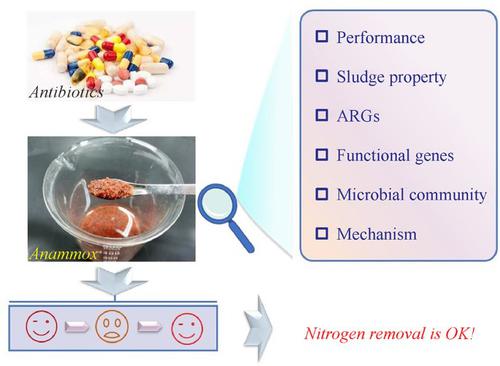Frontiers of Environmental Science & Engineering ( IF 6.1 ) Pub Date : 2020-08-21 , DOI: 10.1007/s11783-020-1309-y Jinjin Fu , Quan Zhang , Baocheng Huang , Niansi Fan , Rencun Jin

|
Antibiotic is widely present in the effluent from livestock husbandry and the pharmaceutical industry. Antibiotics in wastewater usually have high biological toxicity and even promote the occurrence and transmission of antibiotic resistant bacteria and antibiotic resistance genes. Moreover, most antibiotic-containing wastewatercontains highconcentration of ammonia nitrogen. Improper treatment will lead to high risk to the surrounding environment and even human health. The anaerobic ammonium oxidation (anammox) with great economic benefit and good treatment effect is a promising process to remove nitrogen from antibiotic-containing wastewater. However, antibiotic inhibition has been observed in anammox applications. Therefore, a comprehensive overview of the single and combined effects of various antibiotics on the anammox system is conducted in this review with a focus on nitrogen removal performance, sludge properties, microbial community, antibiotic resistance genes and anammox-involved functional genes. Additionally, the influencing mechanism of antibiotics on anammox consortia is summarized. Remaining problems and future research needs are also proposed based on the presented summary. This review provides a better understanding of the influences of antibiotics on anammox and offers a direction to remove nitrogen from antibiotic-containing wastewater by the anammox process.
中文翻译:

厌氧氨氧化工艺处理含抗生素废水的综述:关联效应与相应机理的联系
抗生素广泛存在于畜牧业和制药业的废水中。废水中的抗生素通常具有很高的生物毒性,甚至会促进抗生素抗性细菌和抗生素抗性基因的发生和传播。而且,大多数含抗生素的废水都含有高浓度的氨氮。处理不当将对周围环境甚至人类健康造成高风险。具有巨大的经济效益和良好的处理效果的厌氧铵氧化(厌氧氨)是一种从含抗生素废水中去除氮的有前途的方法。然而,在厌氧氨氧化应用中已观察到抗生素抑制作用。因此,本综述对各种抗生素对厌氧氨氧化系统的单一和综合作用进行了全面概述,重点是脱氮性能,污泥特性,微生物群落,抗生素抗性基因和涉及厌氧氨氧化的功能基因。此外,总结了抗生素对厌氧菌团的影响机制。在提出的总结的基础上,还提出了剩余的问题和未来的研究需求。这篇综述提供了对抗生素对厌氧氨氧化的影响的更好理解,并为通过厌氧氨氧化工艺从含抗生素废水中去除氮提供了方向。总结了抗生素对厌氧氨氧化菌群的影响机理。在提出的总结的基础上,还提出了剩余的问题和未来的研究需求。这篇综述提供了对抗生素对厌氧氨氧化的影响的更好理解,并为通过厌氧氨氧化工艺从含抗生素废水中去除氮提供了方向。总结了抗生素对厌氧氨氧化菌群的影响机理。在提出的总结的基础上,还提出了剩余的问题和未来的研究需求。这篇综述提供了对抗生素对厌氧氨氧化的影响的更好理解,并为通过厌氧氨氧化工艺从含抗生素废水中去除氮提供了方向。











































 京公网安备 11010802027423号
京公网安备 11010802027423号